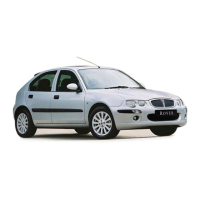Seats
17
1
Seats
CORRECT SEATING POSITION
To avoid the risk of loss of control and personal injury, DO NOT
adjust the seats while the car is moving.
The driver and front passenger seats should be positioned as far
rearward as practical. Ideally the seat should be positioned so that the
steering wheel can be held with the arms slightly bent and the seat back
in a nearly upright position.
DO NOT allow front seat occupants to travel with the seat backs
reclined steeply rearwards. Optimum benefit is obtained from the
seat belt with the backrest angle set to approximately 25° from the
upright (vertical).
Head restraints are designed to restrain rearward movement of the
head in the event of an accident or sudden stop - a properly adjusted
head restraint can considerably reduce the risk of neck and head
injuries.
Make sure your driving position is comfortable and enables you to
maintain full control of the vehicle. A properly adjusted seat helps
reduce the risk of injury from sitting too close to an inflating airbag.
HEAD RESTRAINTS
Adjust the head restraint so that the cushion is level with the
back of the head - NOT THE NECK!
Lift or push down on the padded cushion, to adjust the height of
the restraint, so that the padded cushion is level with the back of
the head.
Turn the right hand bevelled mounting a quarter turn anti-
clockwise to unlock a head restraint and enable it to be removed
from the seat. After replacement, turn the mounting clockwise to
lock the head restraint in position.

